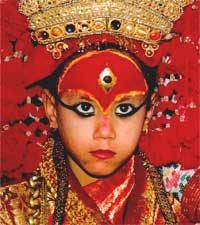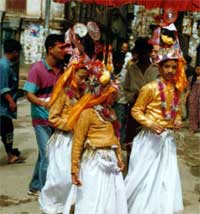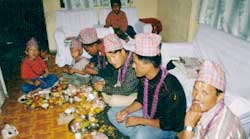Nepal is a land of Festivals.
For the Nepalese, festivals are not merely
the annual spectacles, but also are a
living part of their rich cultural heritage.
Festivals effectively bind together the
Nepalese people of diverse cultural backgrounds
and beliefs into one nation. Most Nepalese
festivals are related to different Hindu
and Buddhist gods and goddesses and they
are celebrated on such days consecrated
for them by religion and tradition.
Others are observed
in honor of personal relatives such as festivals
of Matatirtha and Gaijatra. Yet other are
held to herald the different seasons or
to mark the beginning or end of agricultural
cycle. Some festivals are of national significance
such as Dashain or Tihar; some are confined
to the Katmandu Valley, while still others
are celebrated only within one or two villages
or cities. Nepal (New Year's Day) April-May
The Nepalese follow their
own calendar system known as the Bikram
Era or Bikram Sambat. This festival celebrates
the first day of the first month of the
New Year and is observed as an official
holiday. In Bhaktapur, fifteen kilometers
from Katmandu, the new year celebrations
take on added importance as the "Festival
of Bisket" during a tall wooden post
is erected in one of the main squares.
This festival commemorates the great battle
of Mahabharata, with the wooden post symbolizing
victory.
After two days, images
of god Bhairab and his female counterpart
Bhadra are enshrined in two large chariots
and pulled through crowds of cheering
onlookers. When the chariot reaches a
sloping open square, there is a tug-of-war
between the inhabitants of the upper and
lower parts of the town. Winners are considered
to be blessed with good fortune for the
coming year. The festival concludes with
several days of dancing and worship. Thimi,
another ancient town of the Valley, also
celebrates the New Year with special festivities.
Red Machchhendranath
Festival
This festival takes place in Patan.
During the celebrations the towering chariot
of Lord Machchhendranath is pulled by
ropes through the narrow streets of the
city followed by a large crowd of worshippers.
In front of the chariot, a small crowd
of musicians and soldiers add even more
excitement to the occasion. Over a period
of several weeks, the chariot is slowly
hauled to Jawalakhel where tens of thousands
of devotees burn oil lamps and keep an
all-night-vigil. During this chariot festival
the "Bhoto" or sacred waistcoat,
itself the subject of many legends is
displayed from the chariot as all the
onlookers strain to catch a glimpse of
the lucky sight. A final ritual is then
conducted to mark Lord Machchhendranath's
departure for one year.
Buddha Jayanti (The
Birthday of Lord Buddha)
Buddha Jayanti is a great day for the
Nepalese. This day which falls on the
full moon of the month of Baisakh is celebrated
to commemorate the birth, attainment of
knowledge, and the death of Lord Buddha
the founder preacher of Buddhism, more
than 2500 years ago. It is a thrice-blessed
day. It is the day when he attained Nirvana
(salvation). Prayers are sung and worship
is offered by the Buddhist in leading
Buddhist shrines throughout the country.
At Swayambhunath temple for example, devout
Buddhists gather to chant prayers and
burn butter lamps. The next morning, a
small shrines are visited and worshipped.
Parading groups walk through the streets
of Katmandu and Patan while special flags
fly from all Buddhist households.
Indrajatra
The festival is celebrated by both the
Hindus and Buddhists with great enthusiasm.
The festival continues for eight days
during which time there is much rejoicing,
dancing and feasting. On the first day,
along wooden pole is erected in front
of the ancient Royal Palace at Hunuman
Dhoka, in order to propitiate Indra, the
god of rain. Classical dancers also assemble
at the spot wearing different kinds of
masks and dancing around the courtyard
of Hanuman Dhoka to celebrate Indra's
visit. On the third day of the festival,
the Living Goddess or "Kumari"
is taken out in a procession in a chariot.
Three chariots of Kumari, Ganesh and Bhairav
are taken round the city for three days.
The King also pays homage to the Kumari
during this time. The festival's many
other interesting dances including the
Mahakali, Mahalaxmi, and Dasha Avatara
masked dances, are staged on the plinth
of Narayan temple, just opposite the Kumari
temple. On the last evening of the festival,
the long wooden pole erected on the first
day is lowered amid religious ceremonies
and animal sacrifices
Mani Rimdu
This typical Sherpa festival is celebrated
exclusively in the Lama monasteries of
the Mt. Everest region. It is held in
the month of May, mostly on full moon
day at the Thame monastery in he Khumbu
region, near Namche Bazaar at an altitude
of 13,123feet (4000m). A very spectacular
masked dance drama played for three full
days is the main outdoor highlight of
the festival.
July-August Ghantakarna
Taking place towards the end of the Nepalese
month of Sravan, this festivals celebrates
the exorcism of a mythical demon, Ghantakarna,
who, according to legend, was greatly
feared throughout the Katmandu Valley.
The festival is celebrated by acting out
the legendary drama in the streets. To
begin with, children of each Katmandu
Neighborhood collect money from passersby
which is then used to make an effigy of
the demon god. While this effigy remains
in the center of a rough tent-like structure
erected from bamboo poles, one man impersonates
Ghantakarna by smearing himself with white
paint and roaming the local area collecting
donations in a begging bowl. Surrounded
by the crowds of small children, the group
then returns to the effigy and proceeds
to take it to the river for burning, thus
marking the victory of the local inhabitants
over the demon god.
August-September
Gai Jatra
According to tradition dating back since
time immemorial, every family who has
lost one relative during the past year
must participate in a procession through,
the streets of Katmandu leading a cow.
If a cow is unavailable then a young boy
dressed up as a cow is considered to be
a fair substitute. It is believed that
the symbol of a cow, revered as a holy
animal by all devout Hindus, will assist
the deceased relative's heavenward journey.
Later in the Afternoon, nearly everyone
takes part in another age-old tradition
in which all participants dress up and
wear masks; jokes, mockery and humor of
every kind become the order of the day
until the late evening.
Krishnaashtami
Krishnashtami or the birthday of Lord
Krishna, is celebrated in commemoration
of the hero of the Hindu epic, Mahabharata.
On this day, worshippers carry ornate
and decorated idols and pictures of Lord
Krishna through the streets, often with
bands of musicians following or preceding
the procession. In Patan, thousands of
devout flock to Krishna temple to worship
and receive blessings.
Dashain
Dashain is Nepal's most important and
lavishly celebrated festival. The first
day of the festival is known as Ghatasthapana-the
placing of the sacred vessel. According
to the tradition, all devout Hindus should
take an early morning bath in the holy
river and return carrying some sand from
the riverbed. At the same time, a small
clay pot is filled with water from the
same river and placed by the sand. Barely
seeds are planted in this pot and nurtured
for nine days. As with other Nepalese
festivals, this ritual has also a specific
meaning. In this case, the river water
represents the mother goddess Durga, who
according to legend, crushed many powerful
demon hordes in an epic battle. For the
next nine days, devouts, go to different
prescribed sites for early morning bathes.
The next major even occurs
on the 7th day of the festival when the
sacred flowers and leaves are brought
from the old palace of Kind Prithvi Narayan
Shah at Gorkha. When the flowers reach
Katmandu, there is a large procession
to Hanuman Dhoka gate where brass bands
are waiting to celebrate the occasion.
At the same time, guns and cannons are
fired at Tundikhel parade ground.
The eighth day of the
festival is known as Mahashtami and is
marked by a fast by all orthodox Hindus.
In the morning, animal sacrifices are
carried out at temples dedicated to Goddess
Durga.
On the 9th day, all temples
dedicated to Durga are bathed in sacrificial
blood. On this day, even vehicles and
other mechanical items are worshipped
and sacrificed so as to prevent accidents
during the coming year. Similarly, all
instruments, weapons and implements of
all professions are worshipped in the
hope that Durga will bless their usefulness
and accuracy. In the evening, there is
an elaborate sacrifice at the Taleju temple
near Hanuman Dhoka.
The peak of Dashain celebration
is reached on the tenth day known as Vijaya
Dashami, or the Day of Victory. On this
day, all the Hindus are supposed to visit
their elders or superior relatives, starting
with their parents. The main purpose of
this visit is to receive tika and shoots
of the barley known as jamara. Tika is
a red dot or smear placed on the visitor's
forehead by the senior relative. Also
frequently used in other festivals and
even in daily worship, the tika consists
of vermilion powder, rice and curd. As
all visits cannot be completed in one
day, they continue until the end of the
festival.
October-November
Tihar
After Dashain, Tihar is probably Nepal's
second most important festival. The first
day of the festival is crow's day. In
the early morning, worshippers bathe either
in the Bagmati or some other river. After
this the devouts light a small lamp made
of cotton wool and mustard oil, and placed
in a leaf pot. Then the first portion
of every family meal is offered to the
crows.
The second day is known
as the dog's day. On this occasion dogs
are given a red tika on their foreheads
and garlanded with flowers. They are then
worshipped and offered large plates of
food, including many delicacies.
The next day is the cow's
day and these animals are also worshipped
in the similar fashion. This day is even
more important day, as Laxmi Puja, or
the day for worshipping Laxmi the goddess
of wealth also falls on this day. Towards
the evening, small candles or wick lamps
are lighted and placed outside the main
door and along windowsills. This becomes
a very beautiful spectacle as the whole
city, town and village become filled with
little lights.
The fourth day of Tihar
is "self day" or "self
worship". As the name implies,
this ritual aims to felicitate the sprit
dwelling in one's own body.
Brother's day or Bhai
Tika is the fifth and last day of Tihar.
On this day, every sister worships her
brothers by placing a multicolored tika
on their foreheads and offering her blessings.
The brothers then in turn give tika to
their sisters after which gifts are also
exchanged. As with many other festivals,
Tihar ends with a grand feast with all
family members present.


